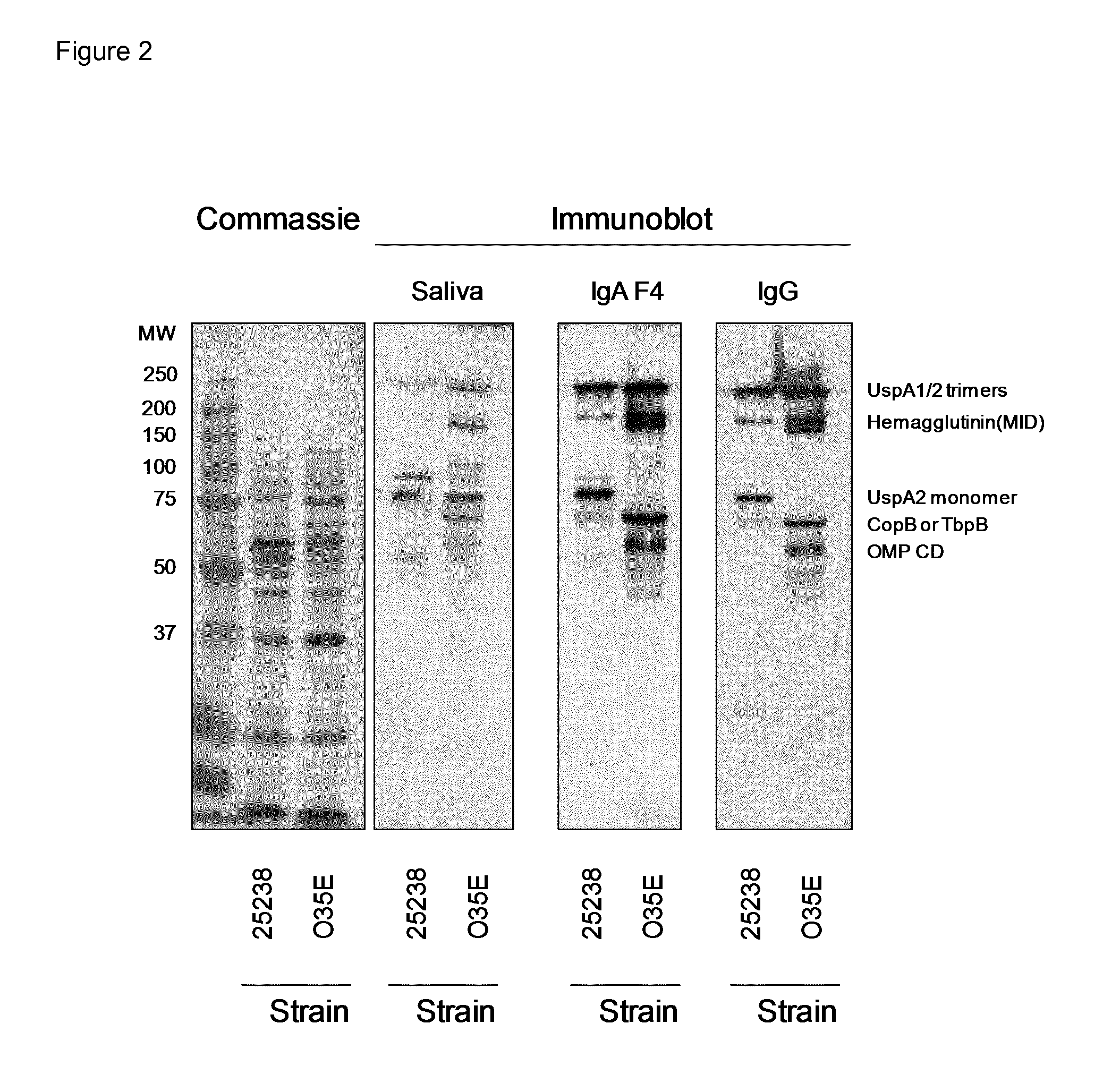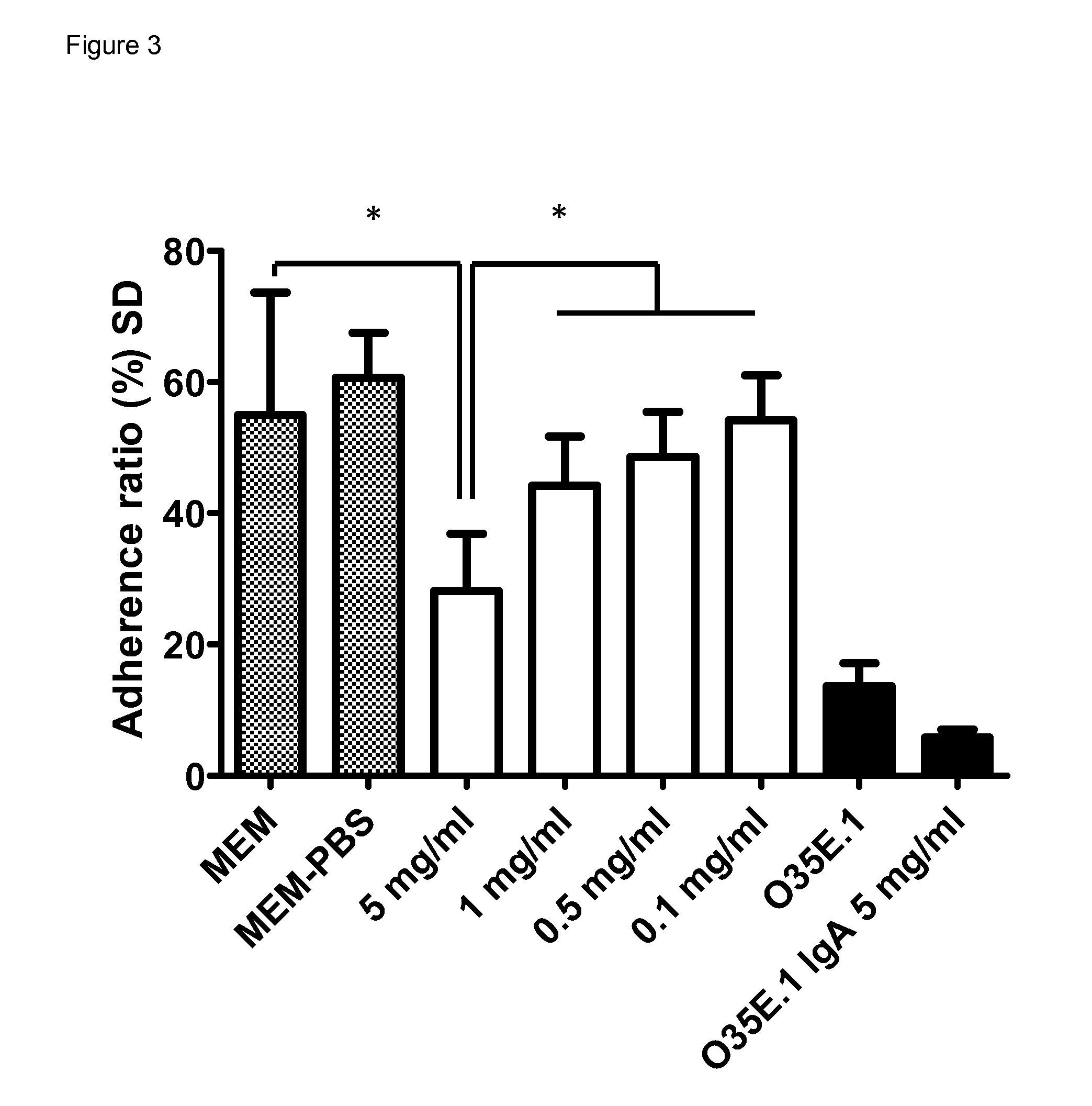Treatment of mucositis with immunoglobulin
a technology of immunoglobulin and mucositis, which is applied in the direction of antibacterial agents, drug compositions, antibacterial medical ingredients, etc., can solve the problems of delayed chemotherapy or radiotherapy cycles, affecting patients' comfort, and increasing the risk of local and systemic infection, so as to reduce oral mucositis symptoms, slow down wound closure, and fast wound closure
- Summary
- Abstract
- Description
- Claims
- Application Information
AI Technical Summary
Benefits of technology
Problems solved by technology
Method used
Image
Examples
example 1
Plasma-Derived and Saliva-Derived Immunoglobulin Preparations Comprise Antibodies that Recognize M. catarrhalis
[0072]To test whether our immunoglobulin preparations could have an anti-microbial effect, we first wanted to establish whether they contain antibodies that recognize a potential pathogen found on mucosal surfaces of the oro-pharyngeal tract. As an example of such a microorganism, we used M. catarrhalis.
[0073]1.1. Bacterial Strains and Human Cell Lines.
[0074]The M. catarrhalis strain 25238 was purchased from the American Type Culture Collection (ATCC). The laboratory strain O35E is a middle ear isolate from a child with otitis media. Bacteria were cultured on brain-heart infusion (BHI) agar plates (Difco, Detroit, Mich.) at 37° C. in an 5% CO2 atmosphere or in BHI broth at 37° C. and 200 revolutions per minute (rpm). In some experiments, bacteria were heat-inactivated by resuspension of live bacteria in PBS and incubation at 60° C. for 60 min. The human pharyngeal cell li...
example 2
Inhibition of Bacterial Adhesion to Epithelial Cells
[0082]To further substantiate the anti-microbial effect of our immunoglobulin preparations, it was tested whether the immunoglobulin preparations were effective in inhibiting the adhesion of M. catarrhalis to pharyngeal epithelial cell line Detroit 562.
[0083]The ability of M. catarrhalis to adhere to human epithelial cells in vitro was measured as previously described (Aebi C et al (1998) Infect Immun 66: 3113-9) with the following modifications. Detroit 562 cells (˜3×105 cells per well) grown overnight to a confluent monolayer in 24-well tissue culture plates in MEM supplemented with 0.1% FCS but without antibiotics followed by washing three times in MEM. Bacteria were grown overnight and adjusted to the appropriate multiplicities of infection (MOI). Live bacteria were added to the wells in MEM without FCS supplemented with the appropriate concentrations of immunoglobulins (prepared as described in paragraph 1.2 above) or controls...
example 3
Inhibition of Bacterial Invasion of Epithelial Cells by Immunoglobulins
[0086]As previously shown (Spaniol V et al (2008) Microbes Infect 10: 3-11), M. catarrhalis is able to penetrate epithelial cells and even localize in the submucosal pharyngeal soft tissue in vivo in children and young adults (Heiniger N et al (2007) J Infect Dis 196:1080-7). Thus, we investigated the potential of human immunoglobulins to inhibit the penetration of pharyngeal epithelial cells in vitro to further demonstrate the potential benefit of immunoglobulin preparations.
[0087]Bacterial invasion was estimated using a gentamicin protection assay as previously described (Spaniol V et al (2008) Microbes Infect 10: 3-11) with the following modifications. Cells were prepared in medium without antibiotics. After washing, bacteria were added at a MOI of 30 together with the indicated concentration of each immunoglobulin prepared as described in paragraph 1.2 above, centrifuged for 5 min at 1,500 rpm and incubated f...
PUM
| Property | Measurement | Unit |
|---|---|---|
| Time | aaaaa | aaaaa |
| Composition | aaaaa | aaaaa |
Abstract
Description
Claims
Application Information
 Login to View More
Login to View More - R&D
- Intellectual Property
- Life Sciences
- Materials
- Tech Scout
- Unparalleled Data Quality
- Higher Quality Content
- 60% Fewer Hallucinations
Browse by: Latest US Patents, China's latest patents, Technical Efficacy Thesaurus, Application Domain, Technology Topic, Popular Technical Reports.
© 2025 PatSnap. All rights reserved.Legal|Privacy policy|Modern Slavery Act Transparency Statement|Sitemap|About US| Contact US: help@patsnap.com



